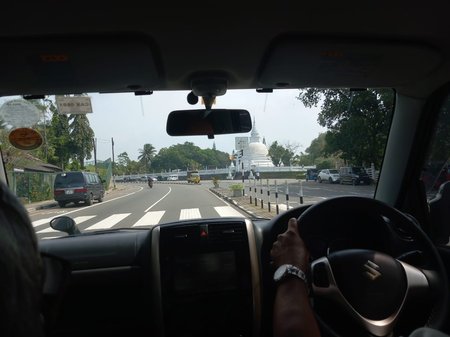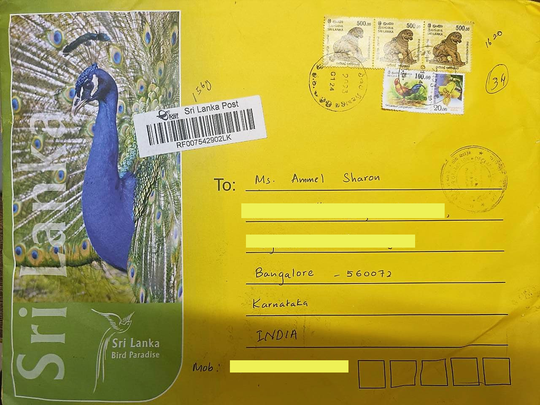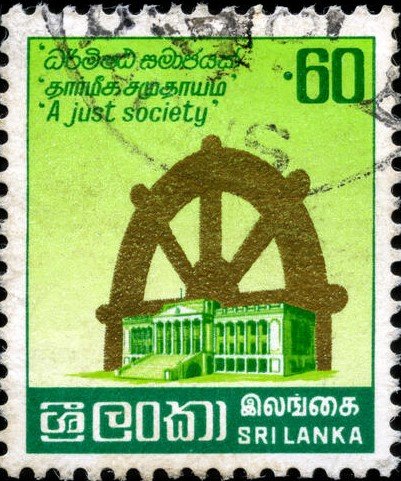
We peered closely at the stamp in our mobile screens, in Colombo and Bangalore, and my friend saw for the first time that the building depicted in it was the Presidential Secretariat. It is a popular stamp, and has been repeatedly issued since at least the late 1970s.
Reflecting on it, my friend is overcome with a sad bitterness, not an effect I imagine a stamp can have on someone. The image brings three elements together: the office of the president, a large Buddhist dharma chakra and a message of a just society. The stamp is synonymous with the policies of the erstwhile premier, J.R. Jayewardene, who served as Prime Minister between 1977-78 and then reigned as second president between 1978-1989. In 1978, he introduced a far-reaching amendment that created Sri Lanka’s second republican constitution – and its fourth overall.
Jayewardene refashioned Sri Lankan politics with an emphasis on Sinhala Buddhism, as evident in this stamp, and effectively fuelled tensions between Sinhalese and Tamils that led to a brutal and fateful civil war on the island.
My friend and I tell each other different accounts of Buddhism; I am honed on narratives of heterodoxy and Dalit conversions. Her accounts often mention the army and Buddhists in the same breath.
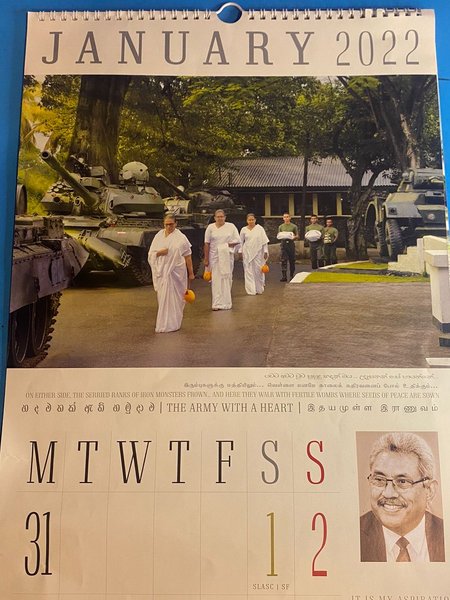
Calendar image with Buddhist nuns walking alongside Army tanks with slogan: 'Here they walk with Fertile Wombs where Seeds of Peace are Sown'.
Sensing my disappointment, she sends me an image of a First Day Cover of a 20th century Buddhist teacher, Walpola Rahula. I listen carefully to what my friend says. We’ve known each other for just under six months, and now I wish to know about her formative years. I learn that she spent many leisurely hours reading in the gardens of the Walpola Rahula Institute. We both work at universities and I imagine her as an undergraduate student, contemplating a purposeful public life in the idyllic grounds of the Buddhist centre.
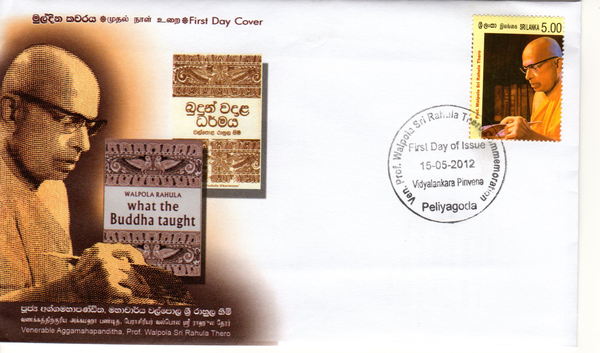
A First Day Cover commemorating Sri Lankan monk and scholar Walpola Rahula. In 1964, he became the Professor of History and Religions at Northwestern University, thus becoming the first bhikkhu to hold a professorial chair in the Western world.
I turn to Prof. Walpola’s book, which became popular in universities in the West. It is an accessible introduction to Buddha’s teachings, and I can see why my friend finds some consolation in Walpola’s humanist words,
The Buddha “said that his teaching was ‘against the current’ (paṭisotagāmi), against man’s selfish desires… the Buddha hesitated for a moment, whether it would not be in vain if he tried to explain to the world the Truth he had just realized. Then he compared the world to a lotus pond: In a lotus pond there are some lotuses still under water; there are others which have risen only up to the water level; there are still others which stand above water and are untouched by it. In the same way in this world, there are still others which stand above water and are untouched by it. In the same way in this world, there are men at different levels of development. Some would understand the Truth. So the Buddha decided to teach it.”
The pursuit of justice requires a pedagogy of optimism. Yet, I wonder if optimism is adequate to the task. On some evenings, my friend recounts incidents of growing up amidst conflict. During the day, however, I receive terse jokes on Whatsapp. If she didn’t have something to laugh about, it would be hard to carry on, she explains.
What do call your sister when she is upset?
Crisis.
This evening, we are meditating on images. Issued by governments, stamps are images of power in circulation. Yet, visuals circulate quickly in our time, and as they invite attention, they also render visual power vulnerable to contestation. In 2022, amidst an economic crisis, Sri Lankans took to the streets in what they called Aragalaya, the Sinhala word for struggle, and stormed the Presidential Secretariat, compelling the President Gotabaya Rajapaksha to flee the country. My friend sends me images in quick succession. “I was present,” she says, of the extraordinary time. “Watch this. It gives me goosebumps still," and sends me a Youtube video taken from a height that spans across the thronging crowds, which has since been taken down. I realize that online, digital archives of public memory may not be so long-lived...
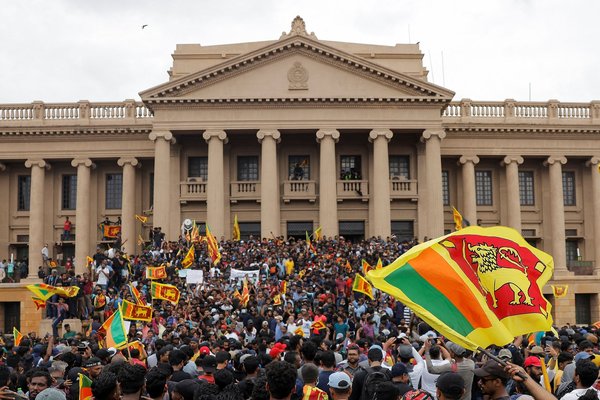
While the world was gripped by the Covid-19 pandemic, the Sri Lankan economy went into crisis, provoking mass outrage among its population who came out into the streets and stormed the Presidential Secretariat. Image: Reuters
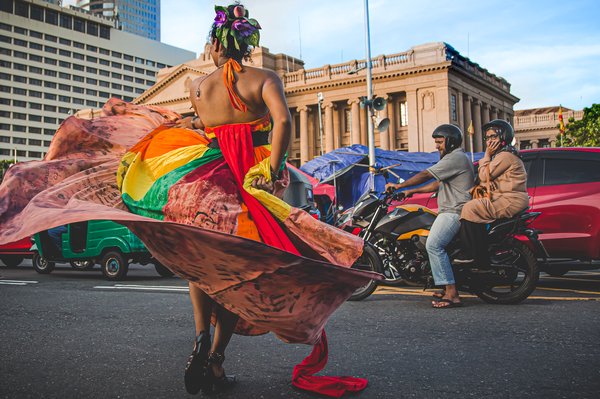
The protests before the Presidential Secretariat were multi-hued. Colombo Pride 2022. Image: Roar.lk
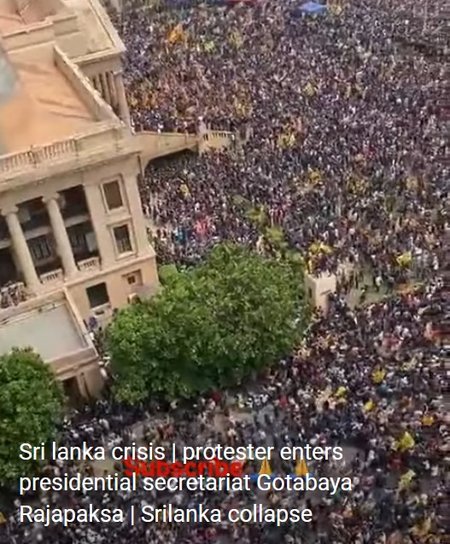
In July 2022, in response to calls of #GotaGoHome, President Gotabaya Rajapaksha fled the country. Screengrab of video no longer available on Youtube.
These images of protest before the Presidential Secretariat on my small screen essay a counter-narrative against a state-mandated ‘just society’. I would like to be transfixed, but the nature of Whatsapp conversations involves continual scrolling, and I am afraid that I will lose this ‘born-digital’ exchange soon.
In contrast, stamps are an anachronism in our times, but serve as a euphemism for our friendship. We go the distance by waiting for each other, unfolding handwritten letters, witness to an origami of feelings.
Soon, I receive a copy in the mail of The Child in Me, a memoir for children by the beloved Sri Lankan writer and illustrator Sybil Wettasinghe. Here, I encounter the wondrous humdrum of southern rural life, with its everyday crafts, its demons and folk insights, as it absorbs visitors who arrive at the Galle port like the Bombay onion seller and Chinese cloth merchant. Here, I read of the kavikolakaraya - breaker of news through poetry - who reads out sorrowful tidings from printed sheets which glum listeners kept as souvenirs. Sri Lankan books are surprisingly hard to come by where I am, and I am thankful for my thoughtful friend who also chooses a special envelope.
The state, eager to have a say in Sybil Wettasinghe's legacy, has issued commemorative stamps. The set of five panels across three stamps narrating one of Sybil’s popular stories is stunning. The philatelist in me is delighted: how lightly the little stamp travels, bearing its message and leaving an impression.
***
Ammel Sharon is associated with Understory.
This essay is a modest tribute to her teacher, the art historian Tapati Guha-Thakurta.
